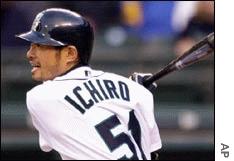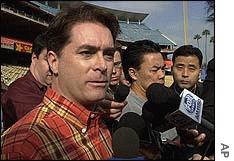|
The latest Japanese import
|
 |
January 22, 2002: 9:59 a.m. ET
Influx of Japanese baseball players could help U.S. majors, hurt Japan.
A twice-weekly column by Staff Writer Chris Isidore
|
NEW YORK (CNN/Money) - They are among the hotter Japanese imports, but their increased U.S. popularity can be bad news for their companies back home.
They are Japanese baseball players, who are coming to the U.S. major leagues in unprecedented numbers. But even as Japanese teams pull in eight-figure fees from the U.S. teams for rights to some of their top players, there is a concern that the Japanese leagues may end up as another minor league feeder system for the U.S. game.
"The product (in Japan) will be lessened," said Jim Allen, a baseball columnist for the Daily Yomiuri, an English-language paper in Japan. "The local demand will remain, but the teams are just realizing now their monopoly is crumbling because of the major leagues. The major leagues have put a major dent on fans' appetite for Japanese baseball."
Baseball is far more popular in Japan than in the country of its birth, where football long ago passed it in popularity. But no one doubts that the U.S. major leagues by far attract the world's best players, partly by relying so much on foreign-born stars.
The new "posting" system with the Japanese league has the potential to feed the U.S. teams with a supply of new, almost reasonably-priced stars.

|
|
|
Ichiro ended up being a bargain for the Seattle Mariners, even after they paid $13 million for the rights to negotiate with the Japanese star. | |
Last year's American League Most Valuable Player, Ichiro Suzuki, was the first Japanese player to come to a U.S. team via the posting system, whereby the Seattle Mariners won a blind auction for the right to negotiate with him. The Mariners paid his Japanese team $13 million in addition to the $14 million they agreed to pay him over three years.
Even with the posting payment, his contract now looks like a bargain. An average of $9 million a year in total cost puts him at maybe half the price of the superstars who came up through the U.S. system.
The losers are all the Japanese teams, who saw interest in their games fall off as Japanese fans turned their attention to the United States.
"Most Seattle Mariners games were televised in Japan last year and a lot of fans here tuned in to watch Ichiro and [Japanese pitcher] Kazuhiro Sasaki play," said Dan Latham, assistant sports editor at the Asahi Shimbun's English-language paper and a scouting consultant for the Atlanta Braves. "At the same time, prime time ratings for Yomiuri Giants games fell to their lowest numbers in several years."
This off-season the Los Angeles Dodgers agreed to pay $11.25 million for the right to negotiate with Kazuhisa Ishii, one of Japan's top strikeout pitchers. Negotiations on a contract are ongoing. If the Dodgers don't reach a deal, they won't have to pay the fee.
Except for the deep-pocket Yomiuri Giants, most teams seem almost eager to sell their best players rather than risk getting nothing for them if they go to the United States when they become free agents, as did pitcher Satoru Komiyama, who signed with the Mets this off-season, or outfielder So Taguchi, who signed with the Cardinals.
| |

|
|
Dodgers General Manager Danny Evans talks to the press about the team winning the rights to Japanese pitcher Kazuhisa Ishii. | |
"The Yokohama BayStars got burned really bad a few years ago when Sasaki went to the major leagues [as a free agent]," Latham said. "He left the team empty handed when he signed with the Seattle Mariners in 2000. The following year, when Seattle paid $13 million to negotiate with Ichiro through the posting system, I'm sure there were some people in the BayStars front office kicking themselves for not posting Sasaki."
In fact there were reports that Ishii's team, the Yakult Swallows, was disappointed when immediately after Sept. 11 the pitcher said he had decided he didn't want to be posted to a U.S. team due to his family's concerns about safety. The team was relieved when he changed his mind, opening up the way for the $11.25 million fee.
Still, it's not likely that the Japanese leagues will disappear altogether, the way the old Negro League did in the United States after baseball finally became integrated in the 1940s and 50s.
Japanese teams other than the Giants are money losers, used by the companies that own them for promotional purposes.
"There's a fair amount of status in being one of the few companies to own a team," Allen said. "And the parent company can give their free tickets and best seats to the companies they're trying to do business with."
Click here for a look at CNNSI.com's baseball coverage
Despite the growing U.S. success of Japanese players, there are few signs that players there are willing to bypass the Japanese leagues altogether and try to sign with U.S. franchises right out of high school or college, as do players from many other countries.
While stars get less than they would from U.S. teams, Japanese teams traditionally have paid their lesser players more than they would see in lower levels of U.S. franchises.
"In Japan you can be comfortable," Michael Westbay, another baseball writer in Japan, said. "In the Dominican Republic, people are hungry. Going from rags to riches, you're more willing to take a chance." 
Click here to send mail to Chris Isidore
|
|
|
|
|
|

|

